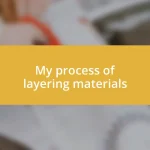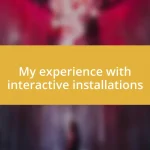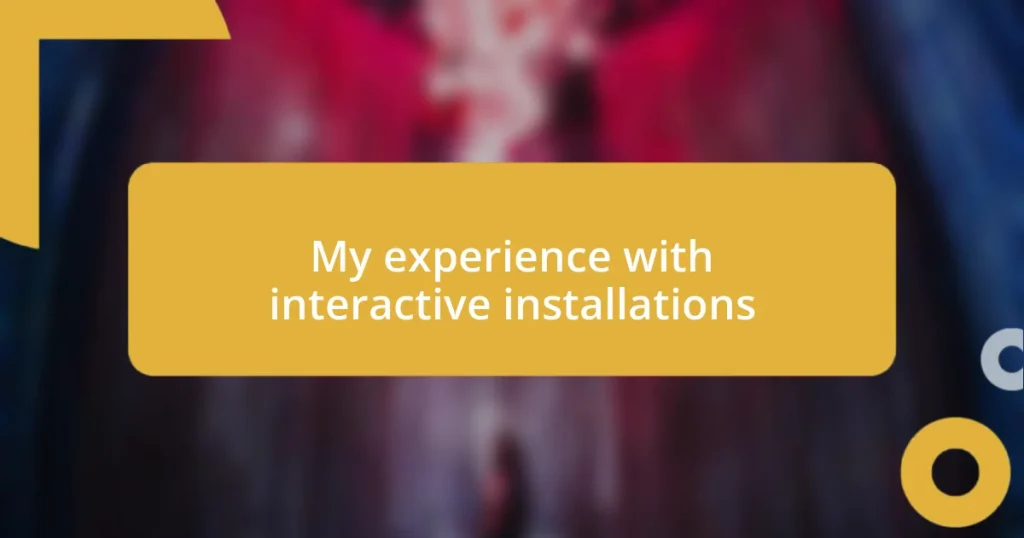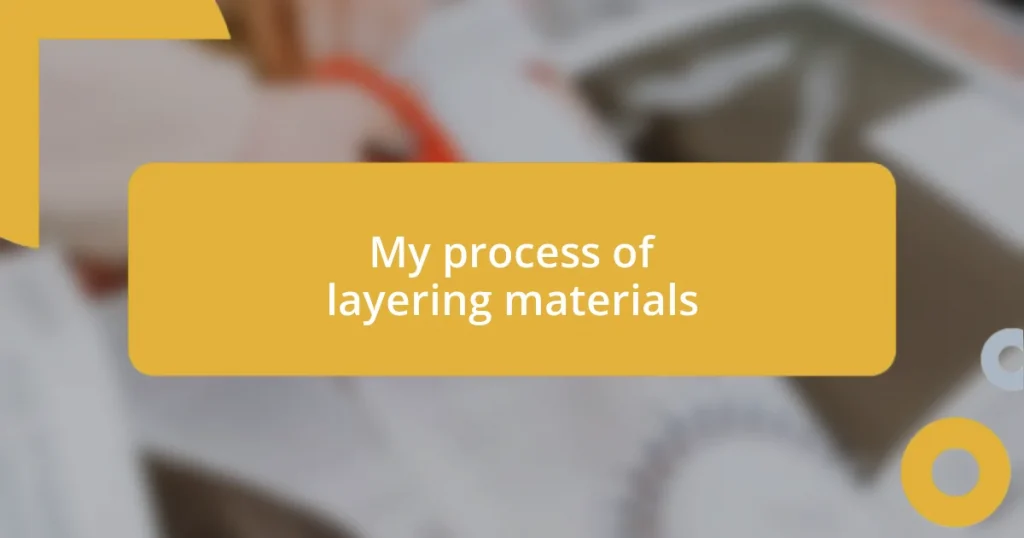Key takeaways:
- Interactive installations foster active participation, blending the roles of artist and observer to deepen emotional engagement and community connection.
- Technology, user participation, and narrative are essential elements, transforming art into dynamic experiences that resonate personally with participants.
- The future of interactive installations holds potential for enhanced emotional responsiveness and global collaboration, revolutionizing the way we interact with art and each other.

Understanding Interactive Installations
Interactive installations blur the line between art and audience, inviting us to actively participate. I remember stepping into an installation where my movements projected colors onto a blank canvas. It was exhilarating—how often do we get to be part of the creative process? In that moment, I felt both artist and observer, a unique experience that I never realized I craved.
What fascinates me about these installations is their ability to evoke emotions through engagement. I once encountered a sound installation that responded to my touch, producing haunting melodies that shifted with every step I took. It made me wonder: how does this interactivity deepen the emotional impact of art? The depth of connection I felt was profound; it transformed a simple sound into a narrative that resonated with my own experiences.
Interactive installations often challenge our perceptions and encourage us to think outside the box. For instance, at a recent exhibit, the walls were equipped with sensors that responded to whispers, creating an environment where silence became a collaborative experience. I found myself hesitating, questioning how my voice would shape the space around me. Isn’t it remarkable how art can turn our insecurities into something meaningful and shared?

Key Elements of Interactive Installations
Interactive installations are designed with several core elements that create an engaging experience. One essential aspect is the use of technology, which can include sensors, projections, and sound. I vividly recall standing in front of a massive digital display that responded to my gestures, allowing me to create waves of light with a mere flick of my hand. It made me realize how vital technology is in transforming an idea into something tangible, sparking a deeper connection with the audience.
Another key element is user participation, which can manifest in various ways. I once took part in an installation that invited visitors to contribute to a growing art piece using their voices. As my friends and I shouted into the microphone, our sounds merged into a chaotic symphony, and I felt an exhilarating sense of ownership. This active participation not only made the artwork dynamic but also fostered a sense of community, reminding me of the power of collective creativity.
Finally, narrative plays a crucial role in interactive installations. They often tell a story that unfolds as participants interact with them. I remember an exhibit where each touch revealed a new layer of storytelling, like peeling an onion. Every movement I made unveiled hidden elements that resonated with my personal experiences and emotions. It made me reflect on how deeply interactive narratives can draw us in, making us feel like we are part of a larger tale.
| Key Element | Description |
|---|---|
| Technology | Utilizes sensors, projections, and sound to engage participants. |
| User Participation | Encourages active involvement, creating a sense of ownership and community. |
| Narrative | Unfolds a story that resonates with the emotional experiences of the participants. |

Techniques Used in Interactive Installations
One of the standout techniques in interactive installations involves using sensory technology to create a dynamic experience. I recall visiting an exhibit where my very breath altered colors projected in the air. The sensation of being able to change something so visually striking with just my breathing was nothing short of magical. It transformed not just the space but my perception of art itself, showcasing how our unassuming actions can become a powerful means of expression.
Another tool often employed is immersive environments, where every element invites interaction. I once participated in a project where the floor was coated with responsive tiles that activated sounds when stepped on. The joy of jumping from tile to tile, each producing different notes, felt like playing my own symphony in real-time. These installations often blend art, technology, and playfulness, challenging us to explore freely and expressively.
- Sensor Technology: Utilizes devices that respond to movement, sound, or light to create a real-time interactive experience.
- Immersive Environments: Engages the audience fully, enabling them to influence the artwork through their movements and actions.
- Feedback Mechanisms: Ensures participants receive immediate responses to their interactions, reinforcing the connection between the audience and the installation.

Evaluating My Interaction Experience
Evaluating my interaction experience with interactive installations reveals some fascinating insights. When I think about the installations I’ve engaged with, I can’t help but feel a rush of excitement. For instance, there was a moment in an exhibit where my touch transformed a blank canvas into vibrant splashes of color. How often do we get to see instant results from our actions? This immediacy created an electric atmosphere among the audience, highlighting how crucial it is for installations to provide real-time feedback.
Reflecting on my experiences, I also noticed how user participation shapes our memories of these interactions. In one installation, I remember collaborating with others to create a collective video projection that celebrated our individuality. Seeing snippets of everyone’s personality come together was surreal. It made me appreciate how our contributions, however small, can create something much larger. Isn’t it powerful to think that our voices, when combined, can lead to unexpected outcomes?
Moreover, the narratives woven into these installations often linger in my mind long after I’ve experienced them. I recall an interactive story where I had the choice to navigate through different paths, each offering unique insights. It felt like being part of a choose-your-own-adventure book, where I controlled the direction of the tale. This level of engagement sparks a deeper connection with the artwork. Have you ever felt so involved in a story that it resonates with your own life? Those moments are truly unforgettable and remind me of the profound impact interactive art can have on our understanding of ourselves and the world around us.

Lessons Learned from Interactive Installations
Experiencing interactive installations has taught me the value of immediate feedback. There was a specific moment when I waved my hands near a digital wall, and the colors danced in response. That feeling of instant interaction sparked an exhilaration within me; it was like a conversation with the art itself. Have you ever felt that rush of excitement when you realize your choices influence what you see? It reminds us how engagement can transform passive viewing into an active dialogue.
I’ve also learned how collaboration can deepen the experience. At one installation, I found myself working alongside strangers, each adding layers to a mural that came alive before our eyes. Witnessing everyone enhance the artwork in their unique style brought a sense of community. Isn’t it fascinating how our individual touches, when combined, can create something wholly unexpected? This experience has shown me that these installations aren’t merely about personal expression; they are also about building connections.
Moreover, I’ve discovered that the narratives within these interactive pieces often leave a lasting impression. Participating in a project where my choices dictated the storyline felt like stepping into a living fairy tale. I was not just an observer; I was part of the tale, shaping its course. Have you ever been so wrapped up in a story that it feels like part of your own life? That connection highlights how powerful interactive installations can be in reflecting our personal journeys and emotions.

Future of Interactive Installations
The future of interactive installations excites me as technology continues to advance and expand the possibilities for engagement. Imagine a space where augmented reality (AR) and virtual reality (VR) intertwine seamlessly, allowing us to enter different worlds just by stepping through a digital threshold. Once, I experienced an immersive AR exhibit where my surroundings transformed as I interacted with virtual objects. The sensation of blending real and virtual worlds felt like stepping into a dream – it’s thrilling to think about how far we can push this experience in the future!
As I look to the horizon, I envision installations adapting to our emotional states. Picture an interactive display that changes based on the mood of the viewer, creating an environment tailored to each individual’s experience. In one installation, I noticed how my emotions influenced the art around me during a moment of reflection. It left me pondering the potential for technology to pick up on our feelings and respond in real-time. Wouldn’t it be remarkable if future installations could tap into our innermost thoughts and amplify our emotional connections?
Moreover, we’re likely to see enhanced social interactions, as installations become platforms for global collaboration. I recall joining a live-streamed artwork where participants from different countries created a global mural in real time. It was inspiring to witness diverse perspectives converging through art. Imagine the possibilities when installations become the heart of global conversations! Could this foster a more profound understanding and appreciation of our collective cultures? The future of interactive installations not only invites us to engage but also positions us as active players in a shared narrative, weaving together our stories through art.












